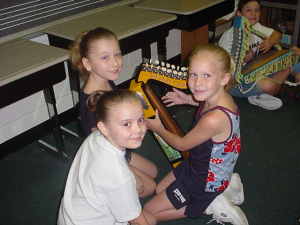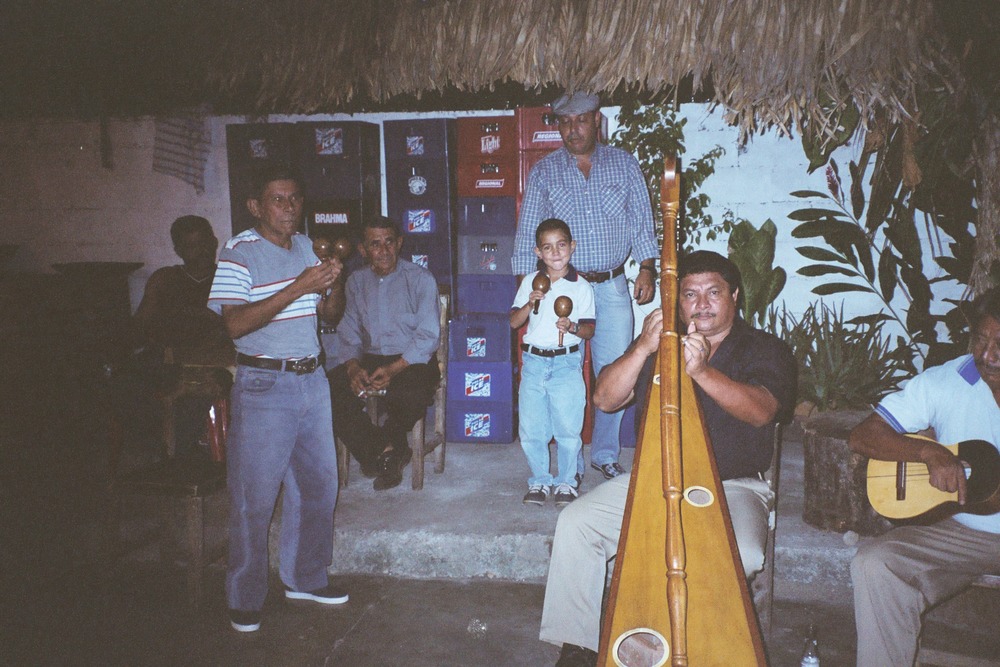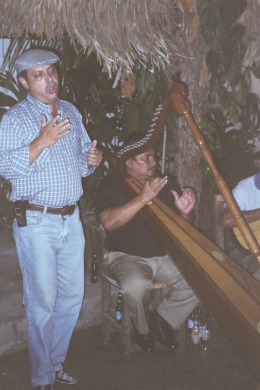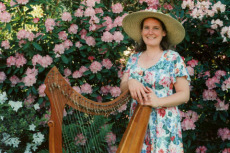(Transcribed with minor editing on November 5, 2003)
Dear friends of Harping for Harmony,
I find that the idea of harping for harmony has really taken off, in just a few short months. However, it is still very formative. Upon my return from El Salvado in July, I had 12 harps, 10 of which were either made or decorated in El Salvador. Nine of these went to new homes right away. No more Salvadoran decorated harps will be available unless and until there is another trip. If you have received one of these harps, this letter is partly an effort to follow through on my commitment to help you start harping. If you happen to have ELECTRONIC MAIL, you can get a lot of help from the HARP listserver group (2003 update: go to www.yahoogroups.com and search for "harp"). You also might want to join the International Society of Folk Harpers and Craftsmen, http://www.folkharpsociety.org. Their Folk Harp Journal is the best place to find stories, pictures, and ads for instruments, music, methods, videos, etc.
ON HARPING FOR HARMONY
The idea of harping for harmony came to me in the Spring of 1994, and lots of things have happened since then. Of course, the idea is nothing new. The harp is an ancient and powerful symbol, with mythical and mystical significance. I consider as partners each of you who has contributed encouragement, money, or materials, or who plays the harp with our mission in mind. This effort of ours is not for profit, and the money we raise is dedicated to building peace.
My personal focus now is on the Salvadoran Peace Accords, but effort is needed all across the globe. The idea is to sustain the effort needed for implementation AFTER conflicting parties have reached some kind of agreement. Harping and other joyful activity can strengthen the will to follow through.
POTTERS FOR PEACE
My friend Steve Earp is a potter who spent a couple of years in Nicaragua, forming strong ties with other potters. When the Morgantown Companion Community sponsored a fiesta to raise money for El Salvador, Steve donated fine hand-made bowls which raised several hundred dollars. That is how I learned about POTTERS FOR PEACE. Their "empty bowls" projects are dedicated to relieving world hunger.
In a similar spirit, our "harp project" is dedicated to peace, and especially to the sustained effort that is needed for implementation after agreement has been reached. (Steve and I have talked about creating a special bowl with a harp design. We would sell it to promote both peacemaking and hunger relief.)
MY HARP PROJECT
In late spring, I was planning a June trip to El Salvador with a brigade to help restore environmental damage from the 12-year civil war. I needed a small, portable harp that would stand up under hard use. I discovered John Kovac's simple design, which I adopted with a few changes. Kovac was in the Peace Corps in Peru, and is now a harper and harp-maker in Front Royale, VA.
With technical assistance from the West Virginia University College of Creative Arts, and several local sponsors, we produced parts fo 12 harps. I carried parts for 7 harps to El Salvador in June. I left four with Salvadoran friends, and returned with 10 harps, including 7 manufactured there on the modified Kovac design.
The "Mariposa" design is brightly painted with butterflies, in the traditional style of the Maya. The "Concertacion" model depicts a countryside with people, houses, trees and fields. "Concertacion" is a word which connotes harmony, consensus, and a willingness to overcome differences.
HARPING IN EL SALVADOR
I went to El Salvador hoping to find harping preserved in popular culture. I carried my brightly-painted little 22-string harp openly, almost everywhere, and I played on buses and street corners, at churches, and in parks and homes. People called it "arpa del Rey David." This King David was, of course, the shepherd boy who played harp for King Saul in the old testyament story. Saul's anger was cooled, in the earliest recorded instance of harping for harmony.
Although Salvadorans were interested in the harp, they were also aware of the lack of teachers and instructional materials. I presented two workshops and various informal introductory lessons on harping, reaching a total of perhaps 40 interested persons. It is a start, but much more is needed. One day I hope to return, and perhaps to find other harpers who would like to go along.
THE MISSION OF HARPING FOR HARMONY is to promote harmony and community, locally and globally, through the sharing of traditional and new music, especially harp music; to recruit young people to play traditional music, especially harp music; and to celebrate the diversity of traditional music through intercultural sharing, especially between Latin America and North America.
HARP PRODUCTION AND ECONOMICS
The Morgantown harp production process is organized for efficiency with mostly skilled volunteers. To produce a run of 10 harps I am budgeting 50 shop hours with 1-3 volunteers working for a total of 50-150 man-hours, or 5 to 15 hours per harp. Material costs for 10 harps amount to about $750. If sold at $225 each, the proceeds amount to $1500, or $10 to $30 per volunteer hour. Elaborate decoration is outside this budget.
The Salvadoran production process is very different, since we are establishing relations with existing or new entrepreneurs and our aims include giving them an economic boost. I do not negotiate for the best price, but simply try to work with interested carpenters and artists, as I do with musicians. As a result, costs and results are variable, but customers must be satisfied or they get their money back.
The finish we aim for is "appropriate," musically excellent and attractive to look at. It is not our purpose to compete with finely crafted harps favored by many harping professionals and amateurs. At the same time, I challenge anyone to demonstrate a better-sounding harp at a comparable price.
THE FUTURE OF ARPA IN CENTRAL AMERICA
"Arpa" is Spanish for harp. ARPA can also be the acronym for an organization which would re-establish the harp in popular culture (Asociacion para el Reestablecimiento Popular del Arpa).
In El Salvador, I presented harp workshops with two organizations actively involved in cultural development: Casa Cultural La Mazorca, and Emanuel Baptist Church. I also found vigorous interest at Resurrection Lutheran Church, at Central American University, and even at the US Information Service at the American Embassy. The harping spirit is moving.
...
Essential for the reestablishment of harping in popular culture is the recruitment and training of new harpers among the Salvadorans, Guatemalans, and Nicaraguans, as well as North Americans. This is not a process controlled by any individual or organization, but we can contribute our efforts each in our own way.
(Update January 2009: See the Guatemalan projects of harpist Patrice Fisher)
Harp on!!
John Lozier
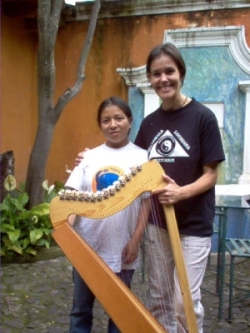 July 22, 2005
July 22, 2005 ing you a photo of Brendy and me and another one with 2 young harpists. Also, a picture of the newest harp that was built in Honduras, which I left in Guatemala for a Children's Music Project. With the funds I will be able to build the next harp.
ing you a photo of Brendy and me and another one with 2 young harpists. Also, a picture of the newest harp that was built in Honduras, which I left in Guatemala for a Children's Music Project. With the funds I will be able to build the next harp.


